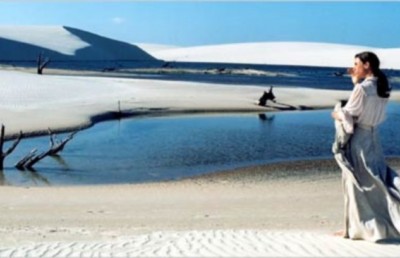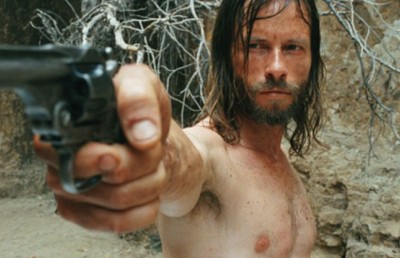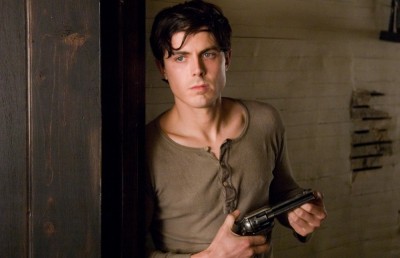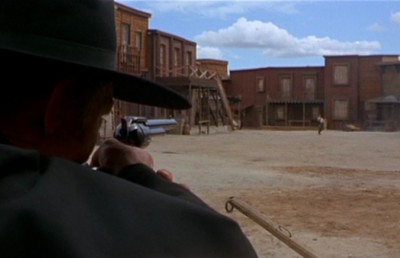Ulzhan: Schlöndorff’s Globalized Eastern Western
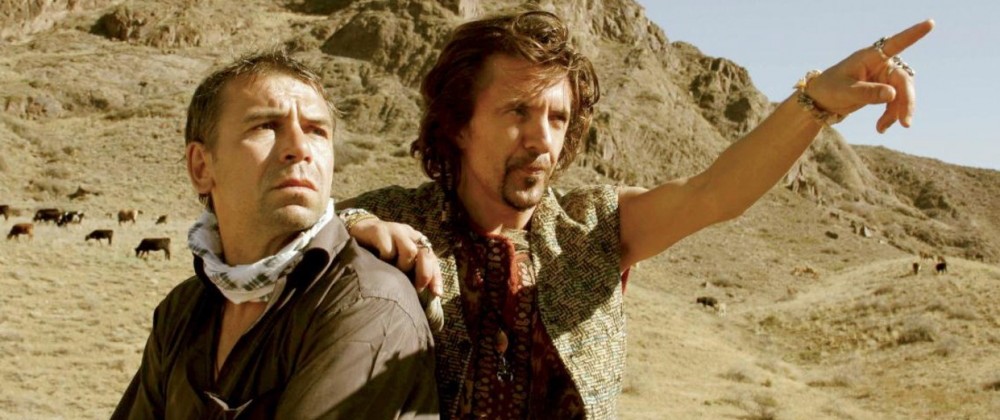
It is a very lyrical film, a love story almost without words. For a change no literature, no politics, and no coming to terms with the past either, but pure free style, a hymn on life—as befits my age.
(Volker Schlöndorff) [1]
Film and media historians will likely look at Fall 2007 as a moment which signaled a major renewal of the Western as once more a significant genre in popular culture. September saw the box office success of James Mangold’s 3:10 to Yuma, Brad Pitt’s winning of the best actor award at the Venice Film Festival for Andrew Dominik’s The Assassination of Jesse James by the Coward Robert Ford (2007), and Emmy Awards for Best Miniseries and Best Made-for-Television Movie given to Walter Hill’s Broken Trail (2006) and Yves Simoneau’s Bury My Heart at Wounded Knee respectively. The weeks that followed saw the U.S. premieres of the Coen Brothers’ No Country for Old Men and Paul Thomas Anderson’s There Will Be Blood, both of which subsequently won eight Academy Award nominations each. Genre critics will no doubt debate the reasons for this renaissance, not the least of which would be the dragged-on persistence of the war in Iraq –a war between Anglo peoples and darker-skinned natives in a desert setting.
Flying under the radar in this return to consciousness of the conventions and structures of the Western may be Volker Schlöndorff’s Ulzhan (2007). Although set neither in the American West nor during the 1800s, the movie is nonetheless an homage to the classic forms of the genre. In one interview, Schlöndorff has indicated that he tried at one point to get the rights to use the theme song from John Ford’s The Searchers (1956), to make explicit the parallel between the wandering hero of Ulzhan and John Ford’s Ethan Edwards. [2] The German filmmaker has created quasi-Westerns in the past, as early as Michael Kohlhaas (1968) and as recently as The Ogre (1996), not to mention the American A Gathering of Old Men (1986). Whereas in Kohlhaas and The Ogre, this preoccupation involved the Western as filtered through the distinctively German genre of the Heimatfilm, in Ulzhan Schlöndorff’s appropriation of the Western serves very different ends. As a film driven by its setting, Ulzhan presents through the Kazakh wilderness an intellectual and cultural frontier on the border between Western materialism and Eastern spirituality. Although Schlöndorff does not fully throw off all traditions of European colonialist thinking in Ulzhan, he nonetheless presents in this film the vision of a globalized filmmaker who attempts to confront the legacy of imperialism and the potential for Europeans to overcome it.
Following its world premiere at the May 2007 Cannes Film Festival, Ulzhan was released in Germany on December 13, to predominantly positive press reviews. The critic of the Süddeutsche Zeitung calls it a “beautifully filmed, mirrored Western” and repeatedly draws associations to The Searchers. [3] The Welt perceives “a jewel,” [4] and its local competitor Hamburger Morgenpost sees “Volker Schlöndorff here in top form.” [5] The film has since been nominated for the German Filmpreis 2008. [6]
With Ulzhan, Schlöndorff reconnects to some of his French influences. The screenplay is by Jean-Claude Carrière who had worked with Schlöndorff previously on The Tin Drum and The Ogre. The protagonist of Ulzhan is French, played by Philippe Torreton, one of Bertrand Tavernier’s favorite actors. French is the dominant language of the movie, although it uses several others on its soundtrack. As a coproduction between France, Germany, and Kazakhstan, the movie reflects in both its production structure and its thematics a globalized world.
As with the Western, Ulzhan grows out of the landscape it presents of the Kazakh wilderness. In the very first scene, we see Charles Simon crossing the border into Kazakhstan in his Peugeot with a French license plate. When the border guard asks him if he is a vagabond, he replies, “No, French.” The opening suggests a transportation of the main character and the audience into a place of strangeness or Otherness. As Charles’s car runs out of gas, he abandons it and proceeds on foot, turning into the vagabond he earlier denied being. This decision to abandon his car, as well as his cell phone, is the first link in the narrative chain of events.
Leaving his car behind, Charles starts on a pilgrimage, and in this sense we can see a link in Carrière and Schlöndorff’s narrative to a whole colonialist tradition of French literature about European travelers in the Orient. Edward Said, in Orientalism, writes about this particularly French approach to portraying Asia:
Yet from one end of the nineteenth century to the other –after Napoleon, that is– the Orient was a place of pilgrimage, and every major work took its form, style, and intention from the idea of pilgrimage there. In this as in so many other forms of Orientalist writing we have been discussing, the Romantic idea of restorative reconstruction (natural supernaturalism) is the principle source.
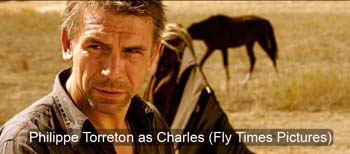
Said continues to discuss how because the French were defeated in colonialist conflicts, their travels in Asia were “imbued with a sense of acute loss.” Said explains:
Consequently French pilgrims from Volney on planned and projected for, imagined, ruminated about places that were principally in their minds [italics in the original] . . . Theirs was the Orient of memories, suggestive ruins, forgotten secrets, hidden correspondences, and an almost virtuosic style of being, an Orient whose highest literary forms would be found in Nerval and Flaubert, both of whose work was solidly fixed in an imaginative, unrealizable (except aesthetically) dimension. [7]
In updating for the film medium this “sense of acute loss” and the portrayal of an Orient of “memories, suggestive ruins, forgotten secrets, hidden correspondences,” Ulzhan is also a Road movie, involving walking, horseback, and helicopter. It traces Charles’s travels east through Kazakhstan to the country’s highest mountain, the Khan-Tangri. As a Road movie, Ulzhan gets its interest as much from the sites and landscapes Charles experiences as it does from his involvement with the people he meets. Schlöndorff has commented that it was not his interest to create a documentary or semi-documentary of modern Kazakhstan. [8] Rather, the images of Ulzhan are always very carefully composed and often serve a metaphoric function, creating landscape of the mind, as it were. They have the beauty and starkness of paintings by Salvador Dali or Giorgio de Chirico, and Schlöndorff has credited his director of photography, Thomas Fährmann, with giving the movie much of its visual style. One remembers, for example, a shot of Charles crouched next to a pillar on top of which is incongruously placed a wrecked automobile. The image not only recalls Charles’s own deserted vehicle; it also projects him as being like a derelict machine rusting away in the desert.
Schlöndorff presents this carefully composed landscape as containing layers of history. In his travels Charles encounters empty places charged with the memory of the Stalinist and post-Stalinist communist era. These include a prison, the remains of a collective farm, and the now radioactive site of former nuclear testing. Kazakhstan becomes a place of contradictions: an oil-rich boom-country, a country largely devoid of villages and towns because it was once populated by nomads, a tribal culture in which ancient wisdom is being replaced by oil rigs and television sets. As with the American Western, the arrival of so-called civilization simultaneously brings with it modern comforts, a spoiling of the wilderness, and a dismantling of precious but underappreciated native cultures. Charles’s first major encounter is an attack not by bandits but by outsourced oil company military agents who fear his being a spy. When they insist on flying him to the capital city of Anasta, the landscape changes from that of an empty wasteland, marred by massive oil drilling machinery, to a synthetic Las Vegas-like urban futurescape. Here, after re-acquiring and then losing a passport and identity papers, Charles sets out on the road again.
On the way, he meets the two other main characters of the narrative. These are Shakuni (David Bennent), a wandering hippie type who seems half Shaman, half charlatan, and Ulzhan (Ayanat Ksenbai), a young schoolteacher in a remote village. As the two accompany Charles to the mountain, they come to embody the contradictions that Kazakhstan presents to the West. As the movie progresses, it plays with the audience’s point of view. Although we begin by seeing Kazakhstan through the eyes of Charles, when Ulzhan enters the picture, we begin to take her point of view in trying to figure out why Charles is wandering, what his past is, and what he hopes to accomplish. As Charles and Ulzhan fall in love, he becomes the strong, silent, mysterious hero with a secret; she is the idealized, youthful, admiring female, one part frontier schoolteacher, and one part Indian princess.
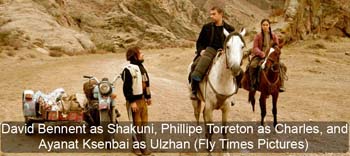
In contrast, Shakuni is the talkative, energetic, semi-comic figure, a serendipitously acquired side-kick. Shakuni seems a Kazakh cousin to Johnny Depp’s Jack Sparrow character in the Pirates of the Caribbean series. With his hoop earring and hyperactive swagger, Shakuni supposedly makes his living by selling unknown words among the rural communities. As the son of a Kazakh Shaman and ethnically German Russian woman, Shakuni’s polyglot heritage makes credible his ability to talk to Charles in more than passable French. He appears to share some of his father’s magical powers and yet still seems an outsider to the people he visits. A product of communist era cultural mixing, he, too, is a remnant from the past.
The trio of characters each contributes to the movie’s theme of the nature of language and communication. Ulzhan, as a teacher of French to children, embodies a bridge between Eastern traditions and Western culture. Shakuni’s selling of rare words proposes a quasi-mystical thesis that words that are untranslatable and specific to a culture are the most valuable. A word like “dharma,” for example, has no good translation in other languages, which suggests that its use produces a singular kind of knowledge. At one point Shakuni proclaims “Languages don’t die,” a statement which seems to defy the effects of cultural globalization. Charles, on the other hand, is the most uncommunicative of the three. He often answers in monosyllables, is irritated when people talk too much, and asserts that he just wants to be alone. It is an irony that the one character who speaks French without an accent is also the character least inclined to talk. Here, the movie connects to the French New Wave and especially Jean-Luc Godard, who was known for irritating traditionalists by using performers like Jean Seberg or Anna Karina whose non-native French was almost a kind of Brechtian alienation effect.
Charles’s silence is central to the movie’s narrative. Midway through, when Ulzhan asks him why he is wandering, he tells her a story of supposed buried treasures near the mountain. More important for him is the prospect of finding ancient manuscripts which will provide clues into the past. This veering off into the conventions of the treasure hunt film is short-lived. It leaves unexplained Charles’s odd behavior of abandoning his car and cell phone, refusing rides, being unconcerned about his passport, and throwing off luggage.
Charles’s moodiness suggests depression and he periodically stares at a postcard and a photograph of a woman and two children. As the movie continues, Charles’s lack of concern for his own comfort, safety, and material possessions makes clear that he is intending either to suicide or to let himself die. At one point, Ulzhan asks him if his family was killed in a car accident and although he does not respond, we sense that she has identified his motives. Previous hints in the movie support this. A child’s suction cup toy clings to the window of the car he abandons. When consulting with a consulate official, he plays with a toy car on the consulate’s desk, inverting it in the manner of an overturned vehicle. He appears shaken by the sight of one of Ulzhan’s students, which implies some past relationship or event.
We might recall how many Westerns hinge on a hero’s motive for vengeance after a family or family member has been murdered. Unlike the goal of vengeance of the heroes of John Ford’s 1956 The Searchers or Budd Boetticher’s Seven Men From Now from the same year, Charles’s goal is one of self-destruction. Nonetheless, here, too, a family-destroying trauma creates the lone rider in the desert.
Charles’s role thus fluctuates between being that of a lover to Ulzhan and that of being a father to his family. A motif of dying fathers emerges. Ulzhan mentions early on that her father is in the hospital, which makes for an otherwise unexplored plot line. If this detail undermines the psychological credibility of her decision to drop everything and follow Charles into the desert, it makes poetic sense if we view this as Ulzhan turning away from her native cultural patrimony and toward a marriage with the West. Late in the film, Shakuni senses during what appears to be an epileptic seizure that his father is on his deathbed. We quickly see the mourning of the deceased father.
Immediately following is a fight between some intruding youths and Charles and Shakuni which reinforces the theme of the reality and power of words. The youths are trying to steal a knapsack whose treasure turns out to be a stash of military death notice letters undelivered to the families of the fallen soldiers from WW II and subsequent conflicts. As in keeping with the theme of words, writings about death are conflated with death itself. After the fighting, Charles remarks that it feels good to fight, and Sakuni responds: “True, it gives you a purpose.” Ulzhan presents one more paradox: that acts of violence or destruction may make one feel more alive. This is one of several contradictions that emerge in the movie. When Charles and Ulzhan spend a night at the abandoned collective farm, she comments on how in the communist era people’s lives were constricted but their basic needs were met. She suggests that the country has gone from being a zoo to being a jungle. In a comparable incident, as the two approach the former nuclear test grounds, they meet a plein-air landscape artist painting the scene into which he will insert a mushroom cloud of a nuclear detonation. As the painter haggles with a pair of art buyers over the price of his bizarrely kitschy canvases, we can see an inappropriate convergence among art, commerce, and images of mass destruction.
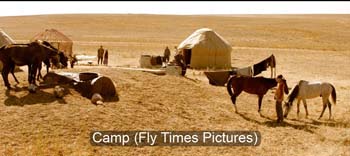
The roles of women in the movie also embody this pattern of opposition and contradiction. In the capital, Charles encounters Irina, a Russian prostitute who is working in an incongruous country-western bar. When the two later have sex, it is quick, rough, and impersonal. In his portrayal of Ulzhan’s relation to Charles, however, Schlöndorff deftly indicates its non-sexual nature. In a shot in which Charles approaches the sleeping Ulzhan, he eventually withdraws without touching her. A later scene in which he arranges her bed covers in the manner more of a father than a lover confirms this. In all, the contrastive scenes suggest Kazakhstan as a country pulled between tradition and Western sexual revolution. The appearance of two kinds of women is remarkably similar to Schlöndorff’s handling of the sexually sophisticated airline stewardess and the Julie Delpy character in Schlöndorff’s earlier Voyager (1991). Indeed, in its treatment of a morose male traveler enchanted by a younger woman, Voyager seems almost a study for Ulzhan or the latter a reworking of the previous movie.
Although Carrière and Schlöndorff’s portrayal of Ulzhan is a positive one, one cannot but wonder if the filmmakers fall into the questionable practice of what Valerie Kenney has critically described as “The West’s feminization of the Orient,” whereby “the East is to the West what the woman is to the man.” [9] Certainly Ulzhan, in her enigmatic innocence and trust, embodies a certain conventional idealization of woman. Of the trio of Charles, Shakuni, and Ulzhan, Ulzhan is the most superficially drawn character –the naïve woman committed to following her man, willing to give up her career to be with him. This subordination of both the woman and the Asian calls to mind Said’s comments in his chapter about Camus of Culture and Imperialism: “For writers like Segalen and Gide, Algeria is an exotic locale in which their own spiritual problems . . . can be addressed and therapeutically treated. Scant attention is paid to the natives, whose purpose is routinely to provide transient thrills or opportunities for exercises of will.” [10] If you substitute Kazahkstan for Algeria, the same charge might be made against Carrière and Schlöndorff.
At the same time, this newer variation on old themes does contain traces of post-colonial political awareness. Charles does not exploit Ulzhan sexually and walks away from the lingerie show the French embassy bureaucrat takes him to in Anasta. He clearly abandons any thoughts of finding the buried treasure that may have excited him as a younger man. And if Charles is to be emblematic of anything, it is clearly in his representing an old order that is ready to die, one that will only find its survival in incorporating into itself the ways and thinking of the East.
If the mushroom clouds Schlöndorff inserts into the nuclear test area sequence are one more foreshadowing of death, we might want to look into the figure of clouds, fog, and snow in the latter part of the movie. Hubert Damisch has written about how clouds in renaissance and post-renaissance painting embody a standard meaning of representing a middle ground between the earthly and the infinite. [11] As Charles and Ulzhan ascend the mountain and hike up into the clouds that surround it, we can clearly read the images metaphorically. Even in the preceding scene, however, images of smoke or steam have suggested this otherworldly transition. In the shot in which Shakuni removes the death shroud from his father in the foreground, bellows of fog can be seen in the background. The mountain is additionally metaphoric in its snowiness whereby the association with winter also aligns with the idea of death and dying.
The end of the movie is highly ambiguous. As Charles and Ulzhan ascend the mountain, Charles begins to throw off baggage. He and she reach a point at which they part, with Ulzhan quickly returning to hug him once more before she descends the mountain with the horses. He looks at the picture of his wife and children, reads the wife’s postcard one last time, and puts them under a rock. Schlöndorff cuts to Ulzhan who, in a parallel gesture, uses a large rock to tether her favorite horse to the ground. In a cut back to Charles, we see him in full shot crying. With the camera placed further away in successive shots, Schlöndorff ends with Ulzhan out of the frame and the horse waiting.
In an interview, Schlöndorff has argued that Ulzhan is correctly confident that Charles will follow and choose life. [12] ??Ulzhan??’s soundtrack supports this reading with a voice over at the very beginning of the movie in which we hear Charles say: “Ulzhan, apple of my eye . . . love’s torments won’t heal.”
At the same time, there is no definitive indication that Charles changes his mind. Earlier in the movie Ulzhan’s grandmother has explained that Khan-Tangri is the place where Shamans go to die. In the scheme the movie sets up, Charles’s choosing death is equally coherent. If we view life as a journey, then its goal is death. In the Hindu tradition, this would be Nirvana. In many Asian religions, life is a burden and death a liberation. If Ulzhan traces a Westerner’s embracing of this ancient tradition, Schlöndorff’s ambiguous ending also suggests that life and death may be so wrapped up together that the outcome is not really important.
Schlöndorff is not the first German filmmaker to present physical traveling as a spiritual journey. Ulzhan is comparable to Ulrike Ottinger’s Johanna D’Arc of Mongolia (1989) in its presentation of Westerners crossing Asian desert and interacting with peoples who are caught between traditional cultural influences and the ways of the West. Ulzhan is also the one Schlöndorff work that could be mistaken for a piece by Wim Wenders. There is more than a small affinity between Charles and ??Paris, Texas??’ Travis in the equation of a physical journey through a barren terrain with a spiritual quest.
What ultimately gives Ulzhan a special complexity is its refusal to let its themes be reduced to a simple bipolar opposition between East and West or nature and civilization or between material and spiritual. Rather Carrière and Schlöndorff triangulate the issues. Carrière and Schlöndorff oppose materialism not only to spirituality but also to the worlds of learning and linguistics. Indeed, the film presents the process of cultural understanding as a kind of mediator between the first two forces. In the location of the mountain top we see embodied material wealth (in the gold reportedly buried there), intellectual wealth (in the documents that may be the key to the ancient cultures), and spiritual wealth (in the place where one may come to terms with issues of life and death). Schlöndorff’s achievement is to make these abstract issues concrete through transposing the conventions of the Western into the frontier between Europe and Asia –physically, intellectually, and spiritually.
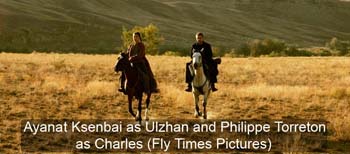
Endnotes
1 Volker Schlöndorff, cit. in “Ulzhan — eine Liebe in Kasachstan.” Kultur & Szene.
2 Volker Schlöndorff. “Man trampelt sich gegenseitig tot.” Interview with F. Göttler and Susam Vahabazadeh. Süddeutsche Zeitung. 13 Dec. 2007.
3 Susan Vahabzadeh. “Funkelnder Irrsinn.” Süddeutsche Zeitung. 13 Dec. 2007.
4 Peter Zander. “Volker Schlöndorff war dann einfach mal weg.” Welt Online. Kultur. 12 Dec. 2007.
5 Marco Schmidt. ??Ulzhan??—Das vergessene Licht. Leise Geschichte von Volker Schlöndorff.” Hamburger Morgenpost 13 Dec. 2007, 9.
6 Deutsche Filmakademie. “Deutscher Filmpreis, Vorauswahl 2008. Programmfüllende Spielfilme.
7 Edward W. Said. Orientalism, 25th anniversary edition (New York: Vintage, 1994), 168-170.
8 Communication from the filmmaker, e-mail to one of the authors of 18 July 2007.
9 Valerie Kennedy. Edward Said: A Critical Introduction (Cambridge, U.K.: Polity Press, 2000), 40-42.
10 Edward Said, Culture and Imperialism (New York: Knopf, 1993), 183.
11 A Theory of /Clouds/ [sic]. Toward a History of Painting, transl. Janet Lloyd (Stanford, CA: Stanford UP, 2002).
12 Untitled attachment of e-mail to one of the authors of 18 July 2007.


